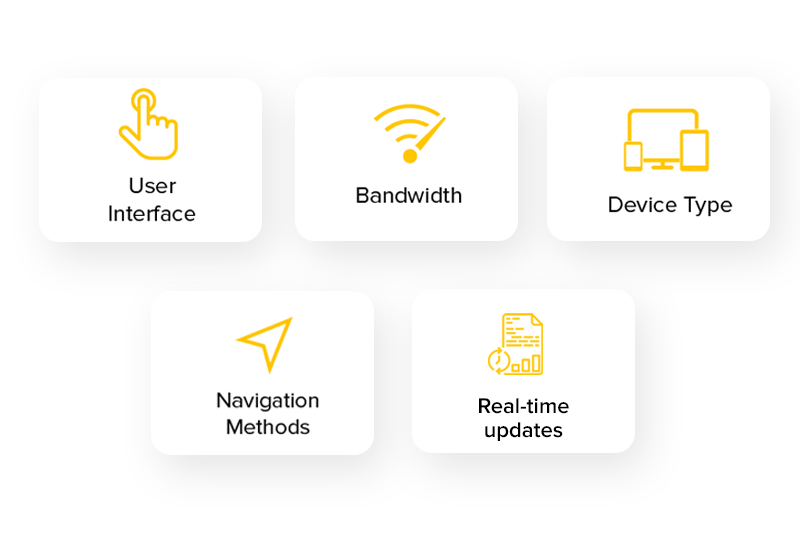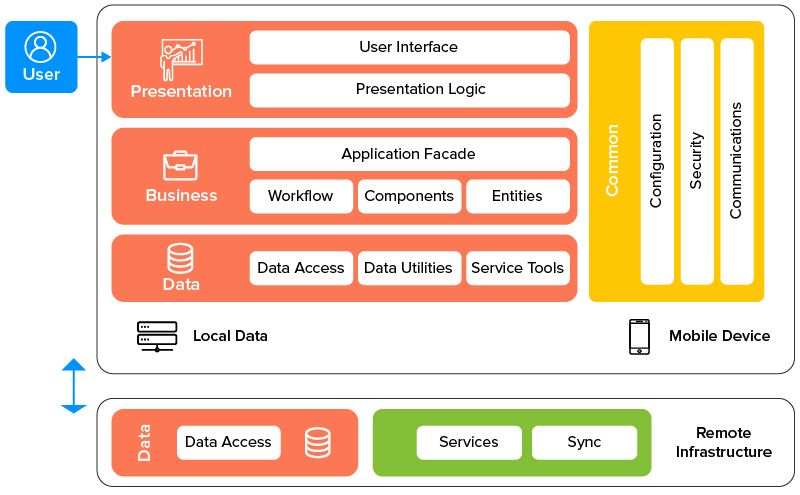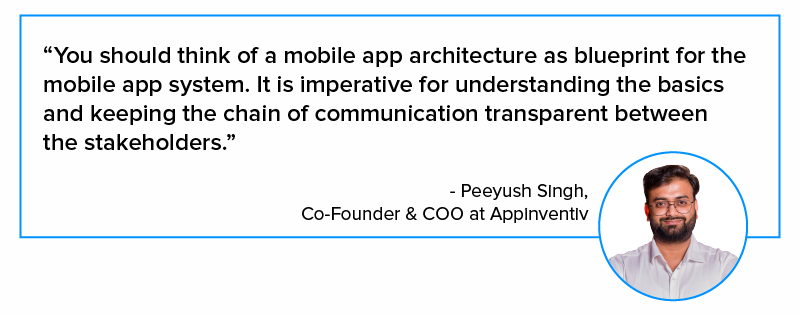Explained: Mobile App Architecture – The Basis of App Ecosystem
What Do We Mean by Mobile App Architecture?
The technical definition: It is a combination of structural elements and their individual set of interfaces using which a system is composed in addition to the framework behavior of all the structural elements.
In layman’s terms: It is a set of techniques and model/design that are supposed to be followed for building a structured mobile app ecosystem. It can also be denoted as an app’s skeleton upon which the working and quality is based.
So, everything that defines an app – how the data would move, the UI/UX, the choice of platform, the tech stack, etc., is a part of mobile app architecture patterns.
However, with a number of apps present in the market striving for users’ attention, a new found pressure has come on every full cycle app development company for coming up with apps that would stand out. All the pressures are focused on ensuring one thing – non failure of the mobile application.
However, more often than not, the reason behind failure of an app can be attributed to app development companies paying less attention to one of the key elements of mobile application development – mobile application architecture design.
So, keeping this in mind, we will be discussing the key elements and layers of a perfect mobile app architecture design.
The Elements to Consider When Developing Mobile App Architecture Design

Device determination
At this stage, you will have to keep the device type into consideration. This would need you to study the screen size, resolution, CPU characteristics, memory, and storage space, plus the availability of the development tool environment.
The app features would have dependency on the software or hardware, which is why it is important to have the details of devices on which the app would run.
Bandwidth status
Throughout its lifecycle, your application will face several events where the internet connectivity will either be dwindling or there would be none at all. Your application architecture diagram will have to be built noting the worst network conditions. You will have to design the data access mechanism, caching, and state management according to the worst case scenarios.
Right User Interface
The importance of UI/UX within an application is unquestionable. Ensuring that your UI is devised to keep users engaged and give them an uncluttered experience is an important part of your mobile application infrastructure – One that would define how well it is designed.
Navigation Approach
While majorly accounted for the app architecture designing front, the element would call for an expertise in both backend and frontend. On the basis of your understanding of who the customers are and what are their app requirements, you should analyze which one of these would be good for your app:
- Stacked navigation bar
- Single view
- Scroll views
- Tab controller
- Search based
- Model controller
- Gesture driven
Knowing the elements will only take you halfway when dissecting the concept to its entirety.
Real-time updates vs Push notifications
While deciding the mobile application architecture diagram, ask yourself whether your users need real-time updates or push notifications. Real-time updates can be compelling but it might be an expensive feature. Plus, this feature may also drain the phone’s battery and data.
All the mobile app architectures are divided into layers. Understanding what they are, helps mobile app development companies understand what architectures are made of. Let us look into the components of mobile application architecture next.
The Three Layers of Mobile App Development Architecture

Presentation Layer
The aim of this layer is to look into how to present the application to end users. When designing this layer, the mobile app developers must identify the correct client type for intended infrastructure. Additionally, the client’s deployment restrictions must also be kept in mind. Another necessity is selecting the correct data format and using robust data validation mechanisms for protecting the apps from invalid entry.
Business Layer
This layer looks into elements on the business front. In layman words, it looks into the way businesses are presented to the end users. This consists of business components, workflow, and the entities under two sub-layer hood: Domain model and Service.
The service layer looks into the definition of common application function set that are available to the end users. While the domain model layer looks into the knowledge and expertise linked to specific problem areas.
Data Layer
The data access layer must meet the application requirements and should help in offering efficient and secure data transactions. Mobile app developers should also consider the maintenance side of the data while ensuring that the data layer can be modified easily with the changing business requirements.
This layer consists of the data specific components such as access components, utilities, helpers, and the service agents.
The three elements of mobile architecture patterns are placed under two subheads: Persistence Layer and Network Layer. The former offers simplified data access which is stored in the mobile app backend architecture, the latter is needed for making networking calls.
The intent of everything you have read till now is to not just understand what is architecture but ‘What is a Good Mobile App Architecture’. Now, what makes an architecture a good architecture is the principle set it is based on.
The Key Mobile Application Architecture Principles
Question: What are the foundations of a good app architecture in a mobile application ecosystem? Answer: A good mobile app architecture best practices (both Android mobile app architecture and iOS application architecture) is the one which enforces good programming patterns and assumptions.
Meeting all these different conditions enables you to speed up the development process while making maintenance much easier. Additionally, a well devised mobile app design architecture in addition to platform centric technology is best used for solving complicated business issues in an effective manner for app projects – something that is fundamental in application development life cycle.

Establishing an architecture as good is an event that calls for it to follow different principles. These principles also hold the answer to how to choose the right architecture for your mobile app.
Portability
It is the system’s ability to react to the changing environment. In the case of mobile apps, the environment changes maybe a lot more frequently noting the market and technological changes. A good architecture ensures that the system is portable enough to answer the changes, keeping the impact of those changes at the minimum.
Maintainability
Noting the requirement changes happening due to the environment changes should be modified to correct the faults, better the performance, etc. In such a scenario, there is always a need for constant app maintenance. A good mobile architecture and programming must ensure high maintainability while reducing the efforts needed to keep the system up and running.
Reusability
A good app architecture must understand that for a faster mobile app development process, it is important that components and protocols can be reused during updations or at redesign. Noting this, it is important that the architecture has the space for adding reusability in the structured app development cycle.
Security
Data security is the most major non-functional need of an application. The architecture must be robust enough for securing the data which is consumed by the app. It should also be in sync with the organization’s security ecosystem, while all the data which is stored on the device must be properly encrypted.
Performance
Users expect applications to be quick and issues free. If the app takes a lot of time to fetch the details, the probability of users abandoning the application increases manifold. A good mobile app architecture should be such that every single one of the users’ expectations are met to its entirety.
This is the stage which would set the basis of your deep diving further into the types of app architecture and having a conversation with the engineering team about the technicalities of your mobile app development lifecycle.
Appinventiv Recommended Ways to Choose a Mobile App Architecture Diagram
As a part of our full lifecycle application development service set, we have been offering custom software development services to our clients belonging to a vast range of industries for a very long time. Here is some advice that our team of designers and developers generally share with our digital partners when it comes to choosing the best mobile app architecture diagram –
- In case you don’t have any budget limitations, it is advised to build native software which provides intuitive performance and functionality.
- If your user base is made of both Android and iOS users and the end goal is to offer the best user experience, Appinventiv advises creation of native applications. But if you want to be present on multiple operating systems like Windows, you can go with cross-platform application development.
- To help engage your customers and your internal stakeholders, we recommend the creation of web and native software development to ensure business visibility and giving your customers the option to access your offering on multiple devices.
Final Note
The success of any mobile application heavily relies on its architecture. Therefore, it’s really important to pay attention to what features you plan to include in your app, how you will deploy them, and how they will be connected in the architectural layers.
The type of architecture depends on many factors such as end-users, type of mobile platforms, and resources available. If it sounds difficult to you, it’s best to plan app development with a mobile app development company, which can suggest which architecture type to choose and the most effective ways to develop your app.

strategies your digital product..




